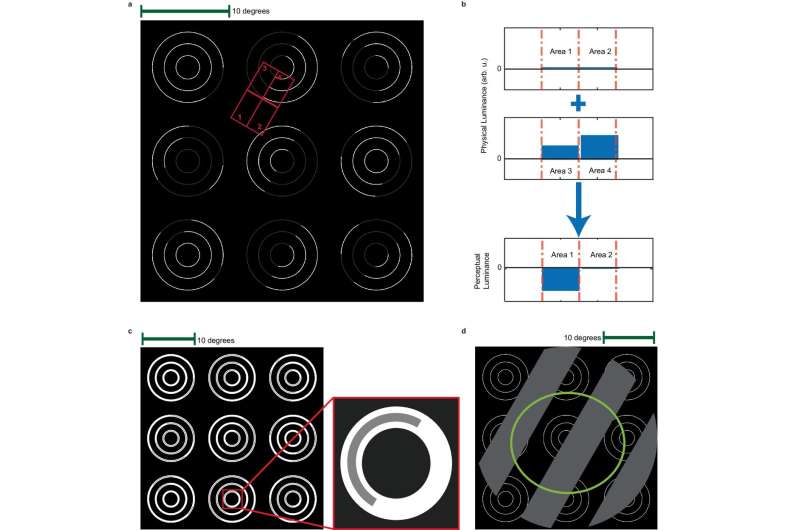
For the first time, research shows that a certain kind of visual illusion, neon color spreading, works on mice. The study is also the first to combine the use of two investigative techniques called electrophysiology and optogenetics to study this illusion. The work is published in the journal Nature Communications.
Results from experiments on mice settle a long-standing debate in neuroscience about which levels of neurons within the brain are responsible for the perception of brightness.
We’re all familiar with optical illusions; some are novelties, while some are all around us. Even as you look at the screen in front of you, you are being fooled into thinking that you’re seeing the color white. What you’re really seeing is lots of red, green and blue elements packed so tightly together it gives the impression of being white. Another example is a fast-rotating wheel or propeller, which can briefly look like it’s reversing direction while it’s accelerating to full speed.
In any case, it might be surprising to know that optical illusions are not just fun to look at but can also be a useful tool to learn more about eyes, nerves, minds and brains.
Associate Professor Masataka Watanabe from the Department of Systems Innovation at the University of Tokyo is on a mission to understand more about the nature of consciousness. It’s a vast subject area so naturally there are many ways to explore it, and among other things, he uses optical illusions. His most recent research looked at whether a certain kind of illusion that works on humans would also work on mice. And it turns out, it does. But why is this significant?
“Knowing this kind of illusion, called a neon-color-spreading illusion, works on mice as well as humans, is useful for neuroscientists like myself, as it means that mice can serve as useful test subjects for cases where humans cannot,” said Watanabe.
“To really understand what goes on inside the brain during perceptual experiences, we need to use certain methods that we cannot use on people. These include electrophysiology, the recording of neural activity with electrodes, and optogenetics, where light pulses enable or disable firing of specific neurons in a living brain.”
Watanabe’s experiment was the first of its kind to make use of both electrophysiology and optogenetics at the same time in animal test subjects exposed to the neon-color-spreading illusion, which allowed his team to see precisely what structures within the brain are responsible for processing the illusion.
“After a visual stimulus lands on the eye, it’s carried to the brain by nerves and is then received by a series of layers of neurons called V1, V2 and so on, where V1 is the first and most basic layer, and V2 and above are considered higher layers,” said Watanabe.
“There is a long-standing debate in neuroscience about the role higher levels play in the perception of brightness and it was not an easy thing to study. Our experiment on mice has shown us that neurons in V1 responded not just to the illusion, but also to a non-illusory version of the same kind of pattern shown. But only when the illusory version was shown to the mice did neurons in V2 also play a crucial role: that of modulating the activity of neurons in V1, thus proving that V2 neurons do in fact play a role in the perception of brightness.”
This experiment has shown that mice models can be effective in this area of neuroscience. Watanabe hopes this is just the beginning and that such experiments will help toward his grand aim of clarifying the neural mechanism of consciousness.
More information:
Alireza Saeedi et al, Brightness illusions drive a neuronal response in the primary visual cortex under top-down modulation, Nature Communications (2024). DOI: 10.1038/s41467-024-46885-6
Citation:
Illusion demystifies the way vision works: Experiments imply brightness perception occurs deeper in brain than thought (2024, April 26)
illusion-demystifies-vision-imply-brightness.html
.
. The content is provided for information purposes only.
